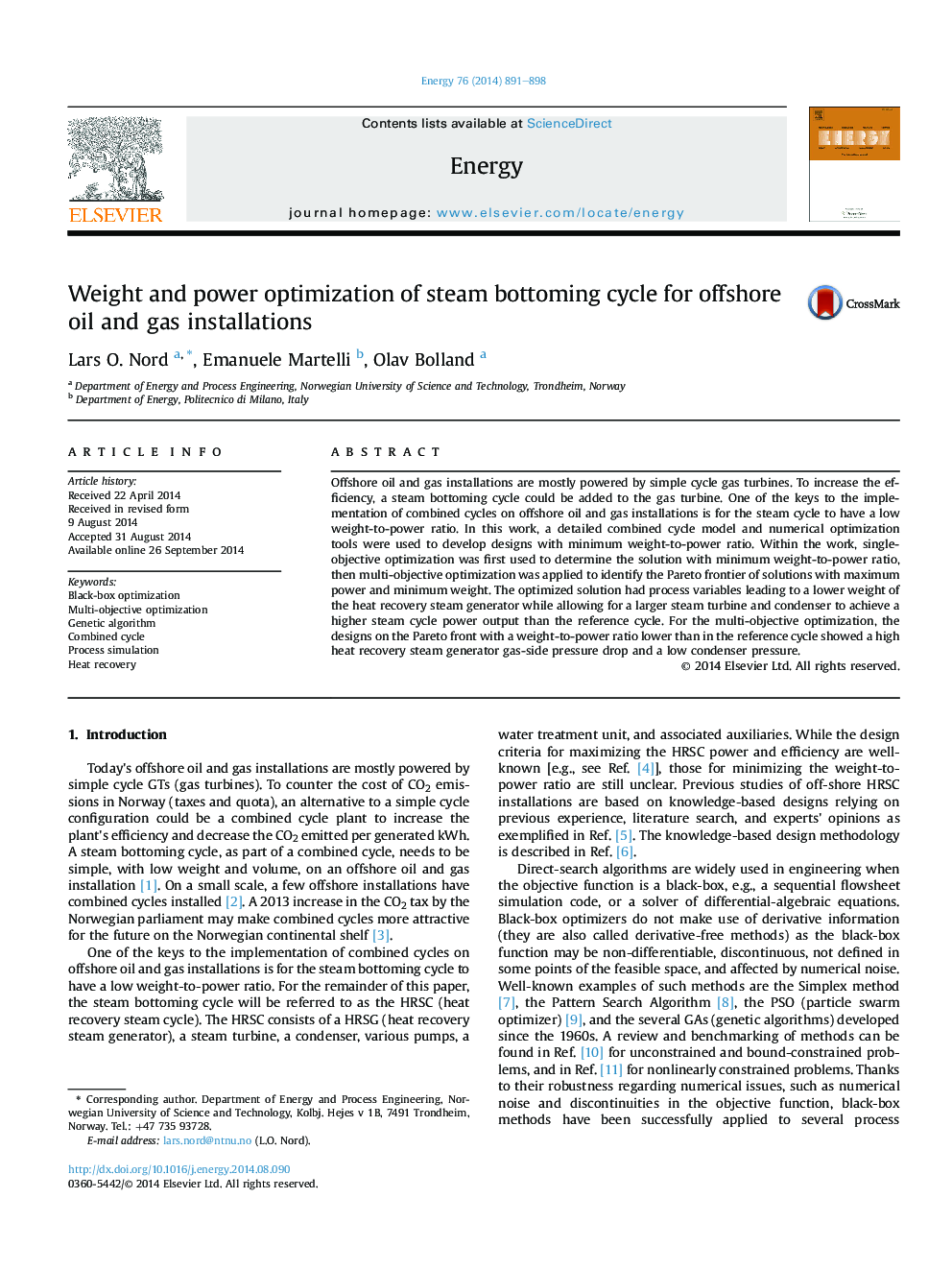| کد مقاله | کد نشریه | سال انتشار | مقاله انگلیسی | نسخه تمام متن |
|---|---|---|---|---|
| 8076933 | 1521470 | 2014 | 8 صفحه PDF | دانلود رایگان |
عنوان انگلیسی مقاله ISI
Weight and power optimization of steam bottoming cycle for offshore oil and gas installations
ترجمه فارسی عنوان
بهینه سازی وزن و قدرت چرخه بخار برای تاسیسات دریایی نفت و گاز
دانلود مقاله + سفارش ترجمه
دانلود مقاله ISI انگلیسی
رایگان برای ایرانیان
کلمات کلیدی
بهینه سازی جعبه سیاه، بهینه سازی چند هدفه، الگوریتم ژنتیک، چرخه ترکیبی شبیه سازی فرآیند، بازیابی حرارت،
ترجمه چکیده
تاسیسات دریایی نفت و گاز عمدتا توسط توربین های چرخه ساده طراحی شده اند. برای افزایش کارایی، یک چرخه عمر بخار می تواند به توربین گاز افزوده شود. یکی از کلید های اجرای چرخه های ترکیبی در تاسیسات نفت و گاز دریایی برای چرخه بخار نسبتا کم وزن و قدرت است. در این کار، یک مدل جامع چرخه ترکیبی و ابزار بهینه سازی عددی برای طراحی طرح با حداقل نسبت وزن به توان استفاده شد. در ابتدا برای به دست آوردن راه حل با حداقل نسبت وزن به توان، بهینه سازی تک منظوره برای اولین بار مورد استفاده قرار گرفت و سپس برای به دست آوردن حداکثر قدرت و حداقل وزن برای شناسایی مرز پارتو از راه حل های چند منظوره استفاده شد. راه حل بهینه شده دارای متغیرهای فرآیند است که منجر به کاهش وزن مولد بخار بازیابی بخار می شود در حالی که برای یک توربین بخار بزرگ و کندانسور اجازه می دهد تا تولید خروجی چرخه بالاتر از چرخه مرجع. برای بهینه سازی چند هدفه، طرح های روی جلد پارتو با نسبت وزن به قدرت کمتر از سیگنال مرجع نشانگر افت فشار بالا در گرمای بخار گاز و فشار کم یخچال است.
موضوعات مرتبط
مهندسی و علوم پایه
مهندسی انرژی
انرژی (عمومی)
چکیده انگلیسی
Offshore oil and gas installations are mostly powered by simple cycle gas turbines. To increase the efficiency, a steam bottoming cycle could be added to the gas turbine. One of the keys to the implementation of combined cycles on offshore oil and gas installations is for the steam cycle to have a low weight-to-power ratio. In this work, a detailed combined cycle model and numerical optimization tools were used to develop designs with minimum weight-to-power ratio. Within the work, single-objective optimization was first used to determine the solution with minimum weight-to-power ratio, then multi-objective optimization was applied to identify the Pareto frontier of solutions with maximum power and minimum weight. The optimized solution had process variables leading to a lower weight of the heat recovery steam generator while allowing for a larger steam turbine and condenser to achieve a higher steam cycle power output than the reference cycle. For the multi-objective optimization, the designs on the Pareto front with a weight-to-power ratio lower than in the reference cycle showed a high heat recovery steam generator gas-side pressure drop and a low condenser pressure.
ناشر
Database: Elsevier - ScienceDirect (ساینس دایرکت)
Journal: Energy - Volume 76, 1 November 2014, Pages 891-898
Journal: Energy - Volume 76, 1 November 2014, Pages 891-898
نویسندگان
Lars O. Nord, Emanuele Martelli, Olav Bolland,
